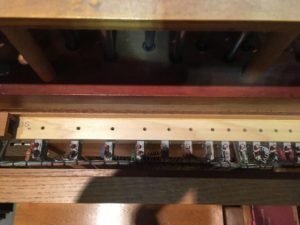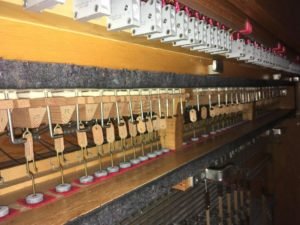The Dobson Pipe Organ at COHS
This instrument, commissioned by Antony Garlick, a professor of music and composition at Wayne State College, Lynn Dobson’s alma mater, has a complicated history. Originally built in 1975, the organ was sold in 1987 to Mrs. Richard (“Buncey”) Brooks of Doylestown, Pennsylvania, and moved by Dobson to her residence in that same year. Some minor revoicing was done to accommodate the new quarters.
In 1997, Mrs. Brooks sold the organ to her parish, the Church of the Holy Spirit, which was then building a new sanctuary in Harleysville, Pennsylvania. Dobson was once again engaged to move the organ. To better serve the much large space, several alterations were made. In addition to three new stops, the main section of the organ was raised about 30″ and new casework, key and stop actions were made to accommodate this change. The organ was reinstalled and completely revoiced by Bill Ayers and John Panning in a four week period in the spring of 1998.
Our organ is maintained by local organ builders Patrick J. Murphy & Associates who performed the work of refurbishing our windchest.
Our organ was built by Dobson Pipe Organ builders in 1975 and rebuilt in 1998 for installation in our church.
Dobson Pipe Organ, Op 2
Wind Chest Refurbishment
January 2021
Our beloved Dobson has undergone some much needed and long planned repairs. The primary focus of the repairs involves refurbishing the windchest. Mechanical action instruments have a variety of felt, leather, and sometimes parchment paper liners throughout the instrument and windchest that keep the flowing air of the instrument going where it needs to go. Wearing, tearing, warping and aging of these parts causes wind leaks that lead to the kinds of issues we are experiencing. The repairs will require the organ to be completely dismantled. Every pipe will be removed and stored at the church. The windchest will then be removed, taken to the Patrick Murphy’s shop, repaired, and then brought back to all be completely reassembled.
We began the discussion of the issues around 2014. Those discussion led to an inspection in 2018 and conversations with both our local organ builder who maintains the instrument, Patrick J. Murphy and Associates in Stow, PA and the company that built the instrument, Dobson Pipe Organ Builders, Ltd.
The inspection results were as follows. This information is quoted from a written report by Patrick J. Murphy.
In the Great pallet box (rear side of the chest) notes 8,11,13,18 showed signs of cracks in the paper membrane that covers the bottom of the chest grid. These cracks were at the back or tail side of the pallets. Cracks in this membrane could be allowing some wind pressure to leak into the note channels. In the Swell pallet box (front side of the chest) notes 10, 11 showed similar signs. There have been temporary repairs made to note 11 on 3/11/15 to stop the reported whimper on that note. All note pallets were manually pulled open during this inspection with the majority of these pallets showing some type of wind seepage.
See photos, the black on the edges of the pallets is a sign of this seepage.



Micro air switches were added during the previous work done by the Dobson firm to provide an action firing mechanisim for the electric magnets that play the Great 8’ Prestant and 8’ Trumpet stops.
In the original construction of the windchests, channel bleed holes were provided to compensate for allowable wind seepage into the note channel. When the wind seepage exceeds the ability of the channel bleed hole to do its job, the note channel begins to fill with a small amount of chest pressure. This is the cause of the intermittent whimpers ciphers on the stops that are controlled by the sensitive micro air switches. Looking at the repair history, adjustment of these micro air switches have been the cause of many of the extra visits. This has been to either stop ciphers or recitfy dead notes as they apply to the Prestant and Trumpet stops.
It is not clear as to the exact reason why so many of the note pallets are showing signs of wind seepage. Possible causes suggest that over time the chest grid surface has become twisted or is not straight as originally constructed. The pliability of the felt and leather appears to also have diminished to effectively retain the proper seal necessary to perform this task. It is also possible that the individual pallet springs strength has lessened over time to the point that they are not suppling enough pressure to ensure a good seal. While possible, I have not experienced this elsewhere in my career. The only way to make an exact determination of the flatness of the bottom of the chest grid would be to remove the main chest and dissemble everything inside of the pallet box. We would true up the grid and apply a new grid surface skin that ensures a flat surface and also seals up all faults or cracks.
Their recommendation was the following would eventually be necessary:
Remove the chest for a complete restoration of the bottom side of the grid, checking for and modifying this surface to achieve the proper flatness, fix all found cracks and apply a new pallet surface skin. Replace all felt and leather on the note pallets. This would require the removal of most of the organs pipe work which would be stored at the church. The organ would be out of service for 2-3 Sundays while repairs are being made in the shop. (Patrick J. Murphy)
At that time, knowing that the organ would need to be taken apart and reassembled and that sanctuary renovations would be taking place in the coming years, we opted to keep an eye on the issues, but hold off until we knew what would be involved in the sanctuary renovations. It would be more cost effective not to dismantle the instrument twice if sanctuary renovations had an impact on the location of the instrument. Sanctuary renovation plans began in 2019. The extent of those renovations and how they may or may not impact the organ were finalized in 2020.
In November 2020 we again approached Patrick J. Murphy for a current estimate to proceed with the needed work. The company recommended the following:
Slider Windchest Refurbishment
Remove the windchest for a complete refurbishment.
Remove chest table and pallet box.
Check grid and bar frame for proper flatness.
Apply new pallet surface skin and chest table to assure flatness.Fix any cracks and glue flood the chest grid. • Replace all felt and leather on the note pallets.
All pipework to be stored at the church.
Return and install of the organ will require 2-4 weeks (organ out of service for an estimated 2-3 Sundays) while repairs are being made in the shop.
In addition to the original plans above, plans have been added to cover the stored pipes, the console and organ case to protect them while the sanctuary is painted during the time the organ is dismantled.




